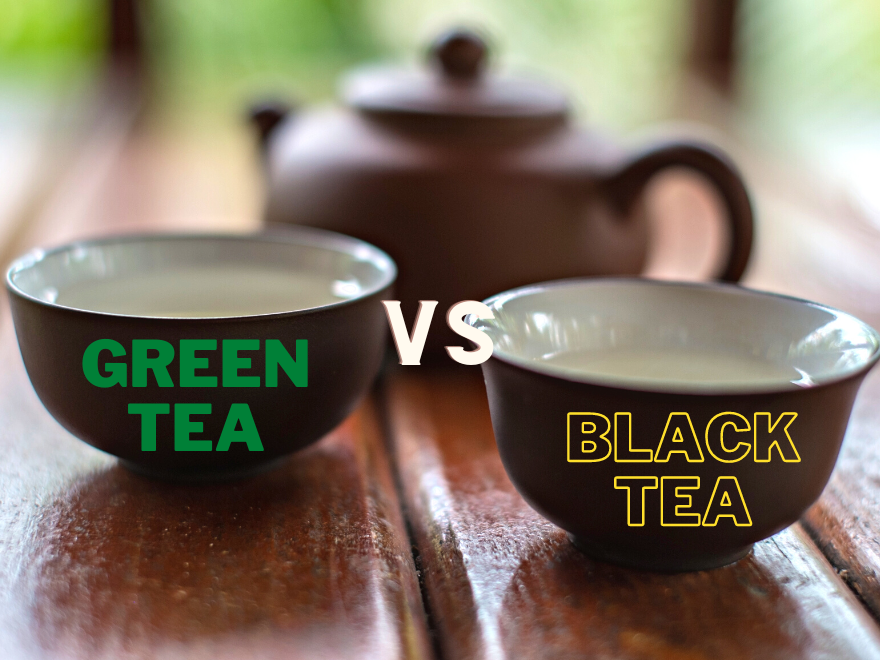
Green Tea versus Black Tea: Which One Should You Choose for Optimal Health Benefits?
Tea is the most consumed beverage in the world after water. The two most popular tea types are green and black. Asking which is better is like an apples to oranges comparison. Understanding how green tea and black tea are similar yet different can help anyone decide which is better for a given situation.
Green Tea vs Black Tea Processing
Despite their differences, green and black teas come from the same plant called camellia sinensis. It's through the production process that they become distinguishably different. Green tea undergoes the four primary steps - withering, firing, rolling, drying. After the tea leaves are plucked, they are heated, shaped then dried. Black tea production includes these four primary steps with the addition of oxidation. Oxidation affects taste, color and caffeine content. Some refer to this step as fermentation but it has nothing to do with bacteria, yeast or alcohol.
In black tea production, the withered tea leaves are gently rolled and bruised to coax the natural juices and enzymes in the leaves to come to the surface. When exposed to air, oxidation takes place and the leaves darken dramatically changing both color and taste. Here’s a diagram of how different teas are made.

Green Tea vs Black Tea Taste
Green tea is closer to the leaves’ natural state while black tea has undergone more processing. Green tea tends to be vegetal ranging from grassy to floral and is more astringent with a light to medium body. Black tea’s oxidation changes its taste to feature more earthy notes which can include oak, malt, smokiness and minerals. Black tea has a heavier body and less puckery. In other words, black tea is rounder and smoother compared to green tea.
What Has More Caffeine Black Tea or Green Tea?
Green and black tea both have caffeine but black tea has 2-3 times more caffeine than green tea. If you’re looking for the caffeine punch, black tea delivers more per cup than green tea. Green tea contains less caffeine than black tea, with around 35 mg per 8-ounce cup. Black tea contains 39 to 109 mg caffeine per 8 oz.
Catechins in Green Tea vs Black Tea
Both green and black teas are rich in protective antioxidants called polyphenols which carry antiviral and antibacterial qualities. Two potent polyphenols present in tea are catechins and theaflavin.
The most potent catechin in tea is epigallocatechin-3-gallate (EGCG). This super antioxidant is touted in an article for Heathline by Ansley Hill as helpful in defending against heart disease and cancer. EGCG is found in concentrated amounts in tea versus in only trace amounts in other foods. EGCG content is lost during processing so green tea has a higher amount of EGCG per cup than black tea. White tea is the least processed tea type and has even higher amounts of EGCG than green tea.
Studies have shown benefits of EGCG include:
- Cancer - Ability to inhibit cancer cell growth (1)(2)
- Alzheimer’s - May reduce effects of plaque accumulation in the brain (3)(4)
- Liver health - Reduce development of a fatty liver (5)(6)
Black and green tea both contain EGCG but more research has been done on the catechin in green tea because the discovery of the benefits of EGCG occurred in Japan where tea consumption is almost exclusively green tea. Scientists noticed adults in Shizuoka had a lower rate of stomach and esophageal cancer compared to other parts of Japan even though the diet and the smoking rate in the region were relatively the same as in other parts of Japan. Researchers discovered that tea consumption in Shizuoka was higher than in other parts of Japan because Shizuoka is the main center for Japanese tea production in the country. This lit the fuse for interest in EGCG and the anti-cancer benefits of green tea.
Theaflavin possesses several health benefits:
- Ability to lower cholesterol (7)
- Ability to lower blood glucose (8)
- Ability to metabolize fat (9)
Theaflavin has been linked to the ability to relax blood vessels and arteries which in turn help to reduce the risk of stroke and heart disease making it equally effective as EGCG in green tea. (10) Theaflavin is responsible for dark pigments in tea. Therefore, black tea is higher in theaflavin compared to green tea. Oolong tea also has more theaflavin than green and white tea.

L-Theanine in Green Tea and Black Tea
L-theanine is an amino acid in tea that provides the relaxing, nirvana effect associated with tea. Green and black tea both contain L-theanine but in general, green tea contains more L-theanine than black tea.
Black Tea vs Green Tea Benefits
There is clear evidence that 3 cups of black tea per day can reduce the risk of coronary heart disease (11). A recent study from the National Cancer Institute concluded that people who consumed two or more cups of black tea per day had a 9% to 13% lower risk of death from any cause than people who did not drink tea. Moreover, higher black tea consumption was associated with a lower risk of death from cardiovascular disease, heart attack, and stroke. This association was proven regardless of the preferred tea temperature, the addition of milk or sugar, and genetic variations affecting the rate at which people metabolize caffeine. Some also suggest that theaflavins may even promote fat breakdown, potentially aiding obesity management.
Additionally, black tea helps boost brain function because of its higher caffeine content and lower L-theanine levels, allowing you to pay better attention throughout the day. Still, drinking black tea enables you to decrease the stress hormones in your body when consumed moderately. (12)
As mentioned, green tea is an excellent source of the potent antioxidant EGCG. For instance, a study on green tea and cancer revealed that consuming green tea reduces your risk of cardiovascular disease by 18% and 33%. They also indicated that green tea decreases your chances of developing several site-specific cancers, such as endometrial, lung, non-Hodgkins lymphoma, oral, and ovarian cancer, by 19% to 42%. This is because EGCG inhibits the growth of cancer cells and even has antimicrobial properties that reduce the transmission of some viruses. (13)
The University of Pennsylvania supported this claim by saying that green tea has a positive impact on liver, breast, prostate, and colorectal cancers due to its inherently potent antioxidants. Green tea has also been shown to be anti-inflammatory, which helps keep your skin clear and glowing and because of lower caffeine content but higher L-theanine, green tea has a more calming effect on your body.
Which is Better?
Better is in the eyes and palate of the beholder. Green and black tea both have notable health benefits and advantages. Which tea is better ultimately comes down to your taste preferences because you have to drink the tea in order for it to be beneficial. If you’re looking for a caffeine boost, opt for black tea. Green tea is the way to go if you’re sensitive to caffeine and want a more calming effect. Rest assured that you are still reaping the health benefits of drinking tea, whichever type you prefer.
Resource links:
- https://pubmed.ncbi.nlm.nih.gov/27338284/
- https://pubmed.ncbi.nlm.nih.gov/21300025/
- https://www.ncbi.nlm.nih.gov/pmc/articles/PMC5477123/
- https://pubmed.ncbi.nlm.nih.gov/26643169/
- https://www.ncbi.nlm.nih.gov/pmc/articles/PMC2586893/
- https://www.ncbi.nlm.nih.gov/pmc/articles/PMC3906112/
- https://www.ncbi.nlm.nih.gov/pmc/articles/PMC5872535/
- https://pubmed.ncbi.nlm.nih.gov/22198621/
- https://www.sciencedirect.com/science/article/abs/pii/S1756464615002716
- https://pubmed.ncbi.nlm.nih.gov/11533262/
- Black tea- help or harmful?
- https://www.medicalnewstoday.com/articles/which-tea-has-the-most-caffeine
- https://www.nature.com/articles/s41430-020-00710-7
Article contributed by Reese Jones and Byron Goo.


Leave a comment